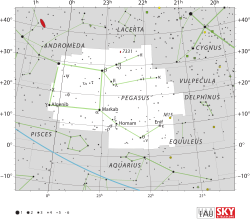78 Pegasi
| 78 Pegasi | |
 | |
| Observationsdata Epok: J2000.0 | |
|---|---|
| Stjärnbild | Pegasus |
| Rektascension | 23t 43m 59,48560s[1] |
| Deklination | +29° 21′ 41,2342″[2] |
| Skenbar magnitud () | +4,93 (V)[3] (5,07 / 8,10) [4], +4,93 (V)[5] |
| Stjärntyp | |
| Spektraltyp | K0 III[6] |
| U–B | +0,63[7] |
| B–V | +0,935 ± 0,001[8] |
| Astrometri | |
| Radialhastighet () | -8,33 ± 0,13[9] km/s |
| Egenrörelse (µ) | RA: 71,10 ± 0,51[1] mas/år Dek.: -40,58 ± 0,35[1] mas/år |
| Parallax () | 14,54 ± 0,56[1] |
| Avstånd | 224 ± 9 lå (69 ± 3 pc) |
| Absolut magnitud () | 0,75[3] |
| Detaljer | |
| Massa | 1,50[10] M☉ |
| Radie | 10[10] R☉ |
| Luminositet | 57,35[3] L☉ |
| Temperatur | 4 898[10] K |
| Metallicitet | +0,01 (Fe/H)[3] dex |
| Vinkelhastighet | 1,1[11] km/s |
| Andra beteckningar | |
| HD 222842[12], 2MASS J23435948+2921412[12], HIP 117073[12], HR 8997[12], IRAS 23414+2904[12], SAO 91457[12], GSC 02257-02521[12], ADS 16957 AB[12], BD+28 4627[12], CCDM J23440+2922AB[12], GC 32954[12], GCRV 14864[12], HIC 117073[12], IRC +30516[12], JP11 3652[12], PLX 5748[12], PLX 5748.00[12], PPM 115769[12], ROT 3444[12], TD1 30043[12], UBV 20408[12], WDS J23440+2922AB[12], YZ 29 14239[12], UCAC4 597-139662[12], WEB 20639[12], 78 Peg, IDS 23390+2849 AB[12], TIC 56229285[12], AG+29 2946[12] och UBV M 27209[12][13] | |
78 Pegasi, som är stjärnans Flamsteed-beteckning, är en dubbelstjärna belägen i den norra delen av stjärnbilden Pegasus. Den har en kombinerad skenbar magnitud på ca 4,93[3] och är svagt synlig för blotta ögat där ljusföroreningar ej förekommer. Baserat på parallaxmätning inom Hipparcosuppdraget på ca 14,5[1] mas, beräknas den befinna sig på ett avstånd på ca 224 ljusår (ca 69 parsek) från solen. Den rör sig närmare solen med en heliocentrisk radialhastighet av ca –8 km/s.[9]
Egenskaper
Primärstjärnan 78 Pegasi A är orange till gul jättestjärna av spektralklass K0 III,[4] som förbrukat förrådet av väte i dess kärna och befinner sig på horisontella jättegrenen och utvecklas bort från huvudserien. Den ingår i röda klumpen och genererar nu energi genom termonukleär fusion av helium i kärnan.[14] Den har en massa som är ca 1,5[10] solmassor, en radie som är ca 10[10] solradier och utsänder ca 57[3] gånger mera energi än solen från dess fotosfär vid en effektiv temperatur på ca 4 900 K.[10]
De båda stjärnorna i 78 Pegasi kretsar kring varandra med en omloppsperiod av 630-år med en excentricitet av 0,11.[15] Följeslagaren är en stjärna av skenbar magnitud 8,10.[4]
Referenser
- Den här artikeln är helt eller delvis baserad på material från engelskspråkiga Wikipedia, 78 Pegasi, 7 juli 2020.
Noter
- ^ [a b c d e] Van Leeuwen, F. (2007). "Validation of the new Hipparcos reduction". Astronomy and Astrophysics. 474 (2): 653. arXiv:0708.1752. Bibcode:2007A&A...474..653V. doi:10.1051/0004-6361:20078357. Vizier catalog entry
- ^ ”Basic data: V* 78 Peg – Double or multiple star” (på engelska). Centre de Données astronomiques de Strasbourg. http://simbad.u-strasbg.fr/simbad/sim-basic?Ident=78+Peg&submit=SIMBAD+search. Läst 10 december 2019.
- ^ [a b c d e f] Anderson, E.; Francis, Ch. (2012). "XHIP: An extended hipparcos compilation". Astronomy Letters. 38 (5): 331. arXiv:1108.4971. Bibcode:2012AstL...38..331A. doi:10.1134/S1063773712050015. Vizier catalog entry
- ^ [a b c] "Sixth Catalog of Orbits of Visual Binary Stars". United States Naval Observatory. Hämtad 26 maj 2017.
- ^ ”78 Pegasi” (på engelska). Universe Guide. https://www.universeguide.com/star/78pegasi. Läst 10 december 2019.
- ^ Hoffleit, D.; Warren, W. H. (1995). "VizieR Online Data Catalog: Bright Star Catalogue, 5th Revised Ed. (Hoffleit+, 1991)". VizieR On-line Data Catalog: V/50. Originally Published in: 1964BS....C......0H. 5050. Bibcode:1995yCat.5050....0H.
- ^ Mallama, A. (2014). "Sloan Magnitudes for the Brightest Stars". The Journal of the American Association of Variable Star Observers. 42: 443. Bibcode:2014JAVSO..42..443M.Vizier catalog entry
- ^ van Leeuwen (2007). ”Hipparcos, the New Reduction” (på engelska). http://vizier.u-strasbg.fr/viz-bin/VizieR-5?-out.add=.&-source=I/311/hip2&HIP=117073. Läst 10 december 2019.
- ^ [a b] Massarotti, Alessandro; Latham, David W.; Stefanik, Robert P.; Fogel, Jeffrey (2008). "Rotational and Radial Velocities for a Sample of 761 Hipparcos Giants and the Role of Binarity". The Astronomical Journal. 135: 209. Bibcode:2008AJ....135..209M. doi:10.1088/0004-6256/135/1/209.
- ^ [a b c d e f] Allende Prieto, C.; Lambert, D. L. (1999). "Fundamental parameters of nearby stars from the comparison with evolutionary calculations: Masses, radii and effective temperatures". Astronomy and Astrophysics. 352: 555. arXiv:astro-ph/9911002. Bibcode:1999A&A...352..555A. Vizier catalog entry
- ^ De Medeiros, J. R.; Mayor, M. (1999). "A catalog of rotational and radial velocities for evolved stars". Astronomy and Astrophysics Supplement Series. 139 (3): 433. arXiv:astro-ph/0608248. Bibcode:1999A&AS..139..433D. doi:10.1051/aas:1999401. Vizier catalog entry
- ^ [a b c d e f g h i j k l m n o p q r s t u v w x y z aa ab ac] SIMBAD Astronomical Database.[källa från Wikidata]
- ^ "78 Peg". SIMBAD. Centre de données astronomiques de Strasbourg. Hämtad 2019-12-10.
- ^ Tautvaišienė, G.; et al. (December 2010), "C, N and O abundances in red clump stars of the Milky Way", Monthly Notices of the Royal Astronomical Society, 409 (3): 1213–1219, arXiv:1007.4064, Bibcode:2010MNRAS.409.1213T, doi:10.1111/j.1365-2966.2010.17381.x.
- ^ Malkov, O. Yu.; Tamazian, V. S.; Docobo, J. A.; Chulkov, D. A. (2012). "Dynamical masses of a selected sample of orbital binaries". Astronomy & Astrophysics. 546: A69. Bibcode:2012A&A...546A..69M. doi:10.1051/0004-6361/201219774. Vizier catalog entry
Externa länkar
- https://www.universeguide.com/star/117073/78pegasi.













